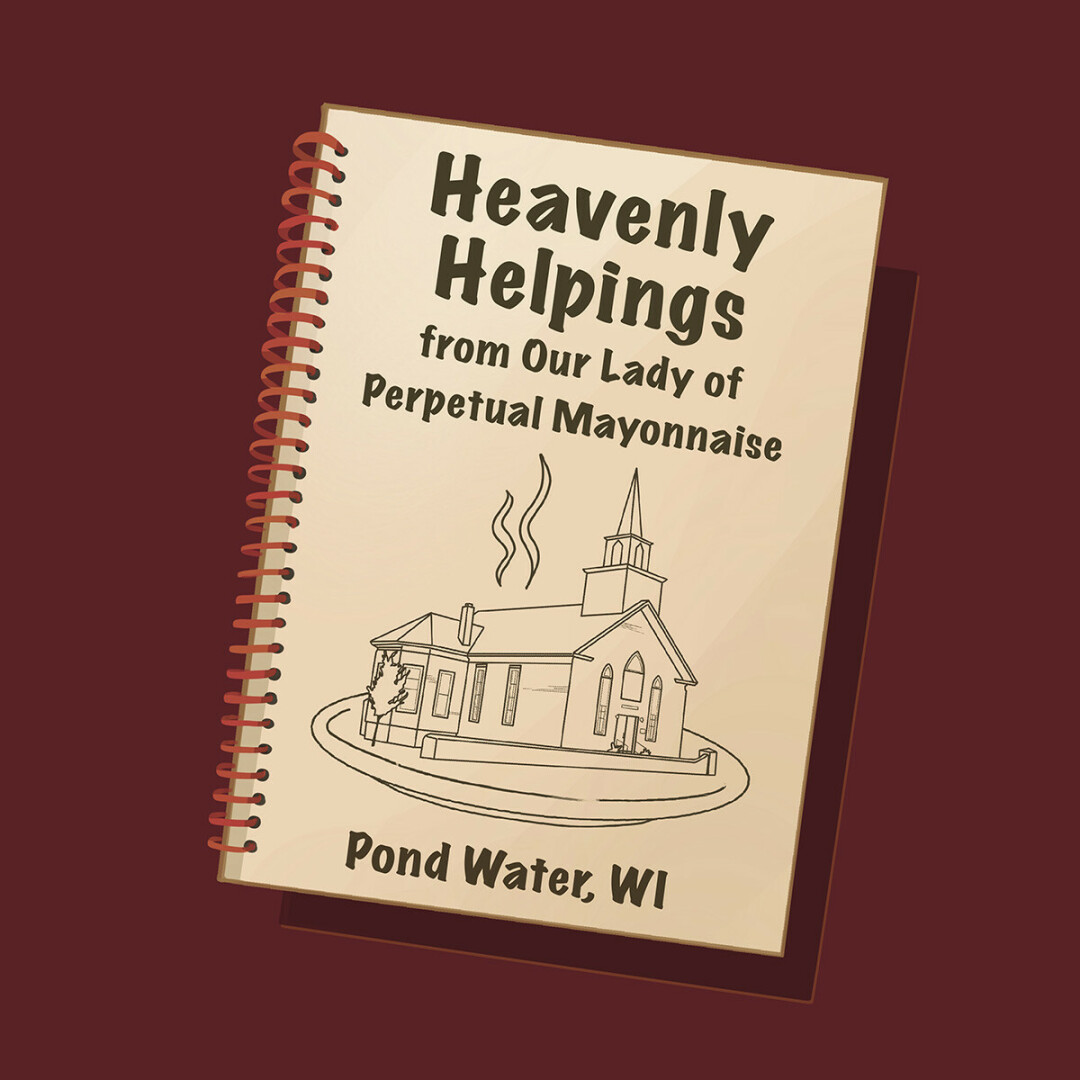THE REAR END: Divine Ingredients
a look at the noble church cookbook
Mike Paulus, illustrated by Eva Paulus |

Many, many, many years ago, like back in 2005, my wife and I harbored a minor obsession with small town church cookbooks. Why? Because they’re hilarious. And awesome. And most of them have some good recipes.
I know Midwestern cuisine is widely ridiculed, to the utter delight of Garrison Keillor and other blatantly un-Midwestern people. So I won’t bore you with jokes about unhealthy amounts of mayonnaise (sweet, sweet delicious mayonnaise) or the unthinkable variety of foods we call “salad.” Instead, I’ll just tell you why I love the humble church cookbook.
You can always find them at garage sales, thrift shops, and you know … churches. Seek them out and crack them open. Where else can you find recipes for squirrel soup, 37 layer bars, and pizza-roll-mac-n-cheese-chunky-chicken-fried-rice-casserole all in one place?
Nowhere is where.
”
I also love finding recipes that force you to do theological research. Usually, these are just a list of ingredients paired with Bible verses, each verse mentioning something like flour, milk, honey, or the fodder of Satan’s wicked pleasure.

MIKE PAULUS
The best part is that recipes are usually contributed directly by parishioners. On one hand, it’s cool to see a community’s favorite recipes gathered together – the best of the best from well-meaning, good-hearted folks. On the other hand, it’s fun to make up stories about those parishioners, especially the ones who contribute well over half the recipes because they’re overbearing, frilly blouse-wearing, church lady control freaks.
I’m looking at you, Millie Knutson.
I think you can learn a lot about the contributors just from the recipes they deem cookbook-worthy. Although sometimes it seems like each member of the congregation was forced to hand in at least one recipe, so they just rattled something off the top of their heads.
For example, one of my all-time favorite recipes is for “Ham Loaf.” Yes, the title by itself is fantastic – a great name for a band or an improv troupe – but check out the ingredients:
• 2 lbs ham loaf
• 1 cup dry bread crumbs
• 2 eggs
• 1 cup milk
• ¼ t. pepper
• NO SALT
Yep, according to someone listed only as “Bill,” the first ingredient in ham loaf is ham loaf. I assume this is just a recipe for kicking your (already delectable) ham loaf dinner up a notch. But Bill could definitely benefit from some creative recipe titling. Someone with more flair (whose name rhymes with Pike Maulus) would have called it Savory Crumb-Crusted Ham with NO SALT.
I also love finding recipes that force you to do theological research. Usually, these are just a list of ingredients paired with Bible verses, each verse mentioning something like flour, milk, honey, or the fodder of Satan’s wicked pleasure. Who are these for? I understand some people love both cooking and reading the Bible, so pairing these two passions is an amazing opportunity, but I’m guessing there’s only seven of them. And they’re all married to each other. And they live in a state that rhymes with “you thaw.” Who else is doing two hours of Sunday school homework just to make a dozen friggin’ oatmeal scotchies?
No one else is who else.
In a lot of these church cookbooks you’ll find joke recipes hidden within the casseroles, salads, and ham loaf crusts. And (not so) oddly enough, many of them involve cooking camels and other animals associated with the Middle East. You’ll be happily paging along when you’re suddenly looking at the ingredients for “Israeli Camel Cake” or something of the sort. I’m pretty sure these goofy problematic recipes began as an email forwarded from somebody’s “kinda” racist uncle. It’s an eye-opening peek at the silent mass of intolerant mayonnaise-lovers living among us.
Anyway, the next time you see a church cookbook sitting on your mee-maw’s counter or in a thrift sale book bin, pick it up and take a closer look. You’ll find a lot more in there than scrumptious recipes for cheeseburger ambrosia lasagna.



















